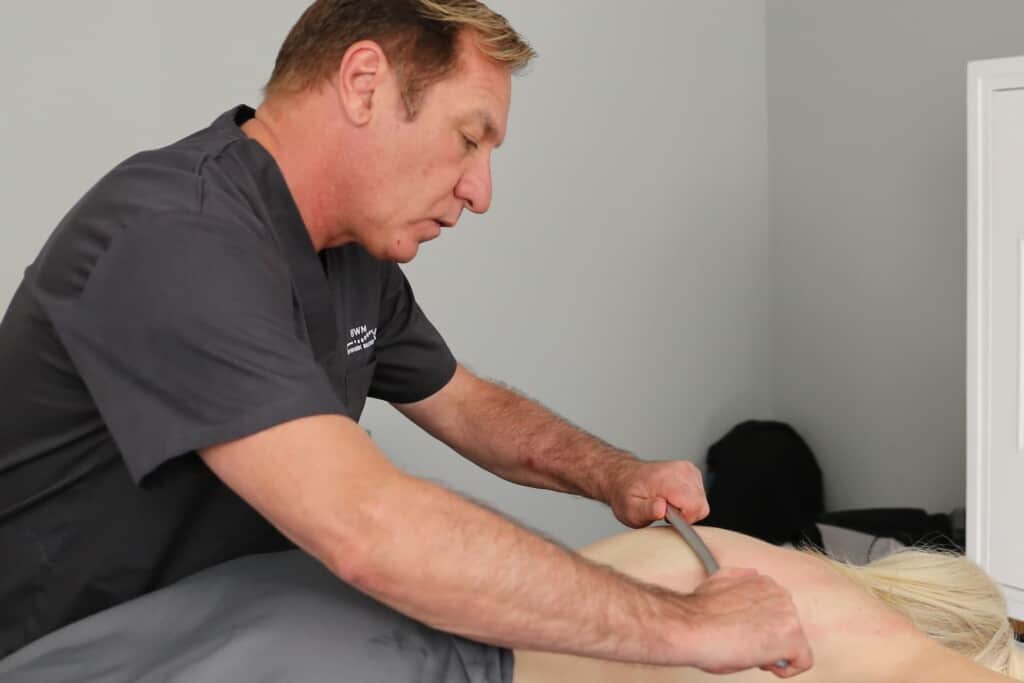This article was originally published on February 24, 2021 and updated on January, 25, 2024.
If you’ve ever wondered about the difference between bodywork and deep tissue massage, you’re not alone. At Bodywork Masters, we frequently field questions from clients seeking clarity. In this blog post, we’ll delve into the nuances that set these two therapeutic approaches apart, helping you pinpoint the best fit for your specific needs.
It’s a common question, and an important one. Let’s start by breaking down the fundamental differences:

What sets bodywork apart is its holistic approach to the body. Instead of just addressing the area of concern, bodyworkers assess the entire body to identify the problem’s source. Often, pain or tension originates in a different area than where it’s felt. Once identified, therapists then determine the most effective techniques to restore fascial health.

The fascial system plays a crucial role in achieving balance and alignment in the body. When the body experiences trauma or injury, fascia acts as a natural bandaid, adhering itself to damaged tissue, joints, or bones—forming adhesions. These adhesions provide protection and facilitate healing, but they can also limit mobility and cause pain.
The goal of bodywork is to break down and release these adhesions, promoting healthy blood flow and eliminating scar tissue. The result is reduced pain, improved mobility, and enhanced balance.
In essence, deep tissue massage is a component of bodywork. Bodywork is better described as orthopedic or manual therapy, and deep tissue massage would be one technique used in the process. The primary objective of bodywork is to maintain optimal tissue health. When clients experience pain due to unhealthy tissue, various techniques, including deep tissue massage, are used to address the issue.
According to the American Massage Therapy Association (AMTA), achieving healthy tissue not only enhances performance, mobility, and flexibility but can also reduce or eliminate the need for pain medication and even serve as a potential alternative to surgery. To explore some conditions bodywork can effectively address, click here.
Don’t wait until you’re in pain to take action. Maintaining healthy fascia is crucial to feeling your best. Consider creating a proactive maintenance plan to keep your connective tissue strong and healthy.
Julie came to Bodywork Masters seeking relief from chronic neck and back pain. She had tried traditional massages in the past, but her pain persisted. After a thorough assessment by Bob Tricomi, a skilled Master Bodyworker, Julie’s pain was traced back to fascial adhesions starting in her upper back and continuing to her lower back.
Through a combination of myofascial release, deep tissue massage, and gua-sha, Julie experienced a remarkable transformation. Her severe neck and back pain began to fade after just one session with Bob. With continued bodywork, she ultimately became pain-free, and her mobility improved significantly.
Julie’s extraordinary progress highlights the benefits of addressing fascial adhesions to elevate overall well-being. Here is what she had to say:
“I cannot express enough how grateful I am for my experience at Bodywork Masters. I had been struggling with severe neck and back pain for a while, and it was affecting my daily life. After just one visit with Bob, I could already feel a significant reduction in my pain. It was truly remarkable how he pinpointed the source of my discomfort.
As I continued with a few more sessions, I couldn’t believe how pain-free I became. It was almost like a miracle!
I now firmly believe that treating the fascia is the key to feeling well, and I am so thankful to Bob for his expertise and skill in helping me regain my comfort and quality of life.”
– Julie T.
Julie’s experience emphasizes the crucial role of tailored bodywork in relieving chronic pain. It’s essential to have skilled and experienced bodyworkers like Bob who can provide customized treatment plans based on a thorough assessment.
Selecting between bodywork and deep tissue massage—or a blend of techniques—depends on your individual needs and preferences. Here are some key takeaways to help you make an informed decision:
Bodywork and deep tissue massage have distinct roles in holistic therapy, tailored to your specific needs. Whether you choose one or the other—or a combination of techniques—depends on your unique needs and goals.
At Bodywork Masters, we prioritize your well-being and offer personalized solutions for pain relief, enhanced mobility, and overall health. Contact us today to begin your journey to a healthier, pain-free you.